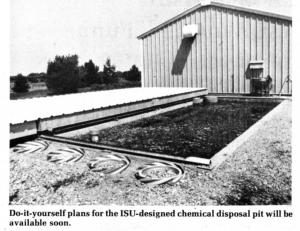1982 - Volume #6, Issue #2, Page #27
[ Sample Stories From This Issue | List of All Stories In This Issue | Print this story
| Read this issue]
A Safe Chemical Disposal Pit
 |
Since 1970, the horticulture specialists at ISU have dumped about 50 different weed chemicals, fungicides, and insecticides into a disposal pit which they designed and built in conjunction with ISU ag engineers and 5 other departments. It has safely disintegrated pesticides so they don't contaminate ground water or the atmosphere.
The ISU disposal pit is 12 ft. wide by 30 ft. long, with 8-in. thick reinforced concrete walls and a 6-in. thick concrete floor. The floor slopes from a depth of 3 ft. on one end to 4 ft. on the other. The pit is filled with alternate 1 ft. layers of gravel and soil. The gravel allows the liquids to seep through and provides aeration, while the soil stimulates biological activity to break down the toxic chemicals.
Close monitoring through the years has shown that the pit has not contaminated the surrounding ground water, nor the air. Each season, 6,000 gals. of water evaporate from the pit, and there has been no leakage through the concrete, researchers report.
A sliding metal cover over the pit remains open for evaporation most of the time. Rain activates the cover so it closes over the pit and keeps rainfall from flooding it. When the cover is closed, there is a screened opening around the base to let air circulate.
During its 12 years of use, all of the 50 or so different pesticides dumped into it have decomposed or been contained. The compounds most resistant to breakdown were atrazine, alachlor (Lasso), and trifluralin (Treflan).
Charles Hall, head of ISU's horiculture department and coordinator of the pesticide disposal project, thinks that the same type of disposal pit could be adapted on a smaller scale for use by individual farmers. He recommends making a pit from a 3-ft. section of 36 in. dia. concrete culvert with the bottom end cemented shut. Alternate 1 ft. layers of gravel and soil should be filled in and the top covered to keep out rain. A screen between the cover and the pit will permit moisture to evaporate, yet keep out animals and children.
Hall recommends diluting concentrated chemicals with water before adding them to the disposal pit. Individual containers should be triple-rinsed to ensure complete chemical removal.
Since the farm-sized pit would be limited in size, Hall recommends storing large volumes of chemicals, such as a partial or complete spray tank load, in a sealed barrel until the spraying season is over and gradually adding the material to the pit over a period of time. He notes that only agricultural chemicals should be added to the pit. "Never, for example, add waste oil to the pit. Waste oil or even dormant oil sprays will cover the surface of the liquid in the pit, prevent evaporation and inhibit biological activity. Oil should be disposed of by burning," Hall points out.
Do-it-yourself plans for farm-sized chemical disposal pits are being developed and will soon be available. For more information, contact: FARM SHOW Followup, Charles Hall, Dept. of Horticulture, Iowa State University, Ames, Iowa 50011 (ph 515 294-2751).

Click here to download page story appeared in.

Click here to read entire issue
To read the rest of this story, download this issue below or click here to register with your account number.




